Have you spotted any lizards in your North Carolina home? Well, the state is home to 13 species of lizards. These cold-blooded reptiles serve as predators and prey to the ecosystem. As predators, they control the number of insects and pests. And as prey, they are food to birds of prey, raccoons, snakes, and more.
Eager to learn more about these animals? Read on!

The 13 Lizards Found in North Carolina
1. Mediterranean House Gecko

| Species: | Hemidactylus turcicus |
| Longevity: | 5 years |
| Good to own as a pet?: | Yes |
| Legal to own?: | Yes |
| Adult size: | 4 to 6 inches |
| Diet: | Carnivorous |
Mediterranean House Geckos are some of the most invasive lizards in North Carolina. They are white, gray, or brown with pink/purple undertones. They have dark mottling and bumps on their skin, and their belly is translucent. They are highly recognized for their large lidless eyes and sticky toepads.
These lizards enjoy habitats with high humidity and warm temperatures. They also love to climb and hide, meaning you can find them in tree barks, cracks, and inside the walls of your home. The Mediterranean house gecko eats insects, moths, spiders, and other small lizards. It is nocturnal, therefore, drawn to outdoor lights when searching for prey.
Their mating season starts from March to July. The female lays 3-6 eggs a year and hides them in trunk cracks, under stones, or in moist soil. The incubation period is 1-3 months.
2. Texas Horned Lizard
| Species: | Phrynosoma cornutum |
| Longevity: | 5 years |
| Good to own as a pet?: | No |
| Legal to own?: | No |
| Adult size: | 3.5 to 5 inches |
| Diet: | Insectivore |
You can tell a Texas horned lizard from its two prominent horns at the back of its head and two more on the sides. On each side of its body are two rows of spiky scales. But despite its appearance, the creature is harmless.
It is a red, brown, or gray animal with dark markings for camouflage. You’ll find three dark lines from its eyes which makes it distinct from other horned lizards. These creatures are docile, diurnal, and solitary. They only interact during the mating season, which starts from mid-April to mid-June.
Their primary diet is insects, and they love harvester ants, termites, grasshoppers, and beetles. However, they, too, are prey. They can dig, dart away, camouflage, puff up to appear larger, and protrude their scales to escape capture.
Unknown to many, the lizard can also shoot blood from its eyes at its predator. How? It restricts the blood leaving the head, causing an increase in blood pressure around the eyes. This action ruptures the thin vessels in their eyes.
The trick works on dogs, wolves, and coyotes as the blood mixes with a foul-tasting chemical. Predatory birds, however, are not deterred by this.
3. Green Anole
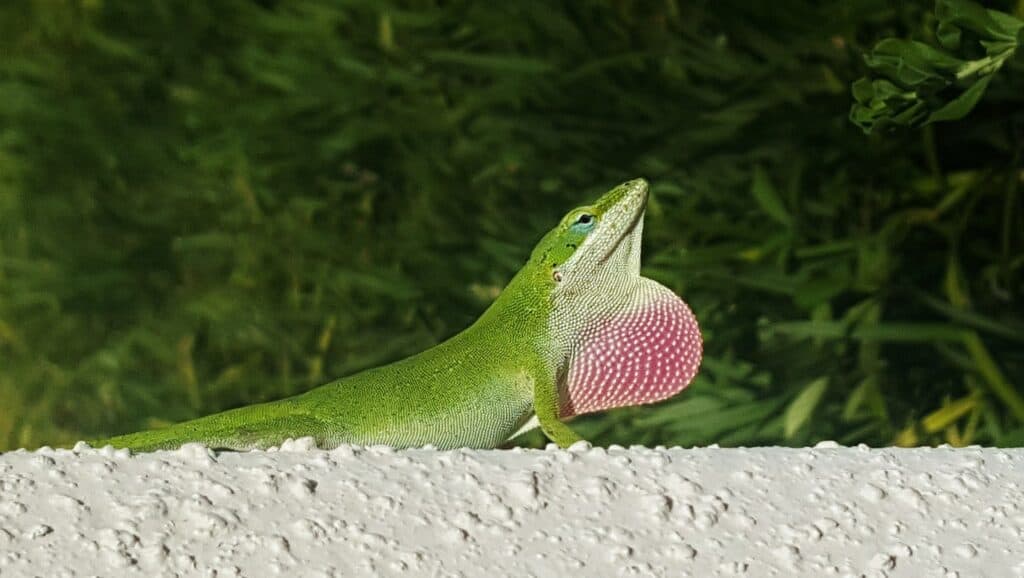
| Species: | Anolis carolinesis |
| Longevity: | 2 to 8 years |
| Good to own as a pet?: | Yes |
| Legal to own?: | Yes |
| Adult size: | 5 to 8 inches |
| Diet: | Carnivore |
Green anoles are arboreal lizards, a reason why they are often spotted on shaded tree branches. Although they are called green anoles, they can change their color to yellow, gray, or brown depending on the humidity, temperament, activity levels, stress, and mood.
Males display a beautiful pink or red dewlap during territorial rivalries with other males or entice a mate. The females, on the other hand, have a white dorsal stripe. These anoles are diurnal and will bask in the sun when not hunting. fighting for dominance.
Their diet includes spiders, flies, moths, ants, crickets, termites, and worms. Their predators are cats, snakes, and birds of prey. The lizards have a 2 to 3 years lifespan in the wild and up to 8 years in captivity.
4. Eastern Fence Lizard
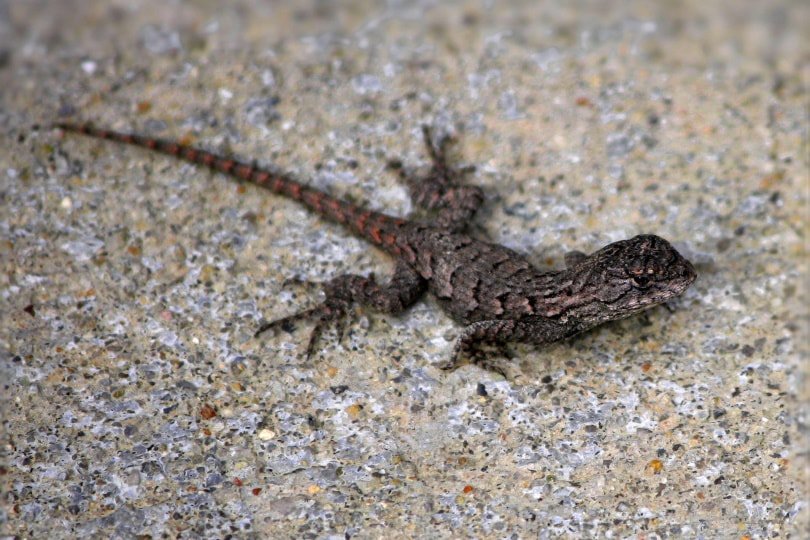
| Species: | Sceloporus undulatus |
| Longevity: | Less than five years |
| Good to own as a pet?: | Yes |
| Legal to own?: | Yes |
| Adult size: | 4 to 7.5 inches |
| Diet: | Carnivore |
An Eastern fence lizard is grayish or brownish with keeled, pointed scales. Males have more uniformed wavy lines on their backs compared to females. The males also have greenish-blue coloration on the throat and sides of their belly during summer.
This medium-sized, spiny lizard can be found in rotting logs, forest edges, firewood piles, or rock piles. They are solitary and territorial too. Males perform push-ups, head-bobs, or flash their blue scales to scare off a competitor.
The lizard hunts ants, spiders, grasshoppers, moths, ladybugs, beetles, and snails. It is prey to cats, dogs, larger lizards, birds of prey, and snakes.
5. Coal Skink
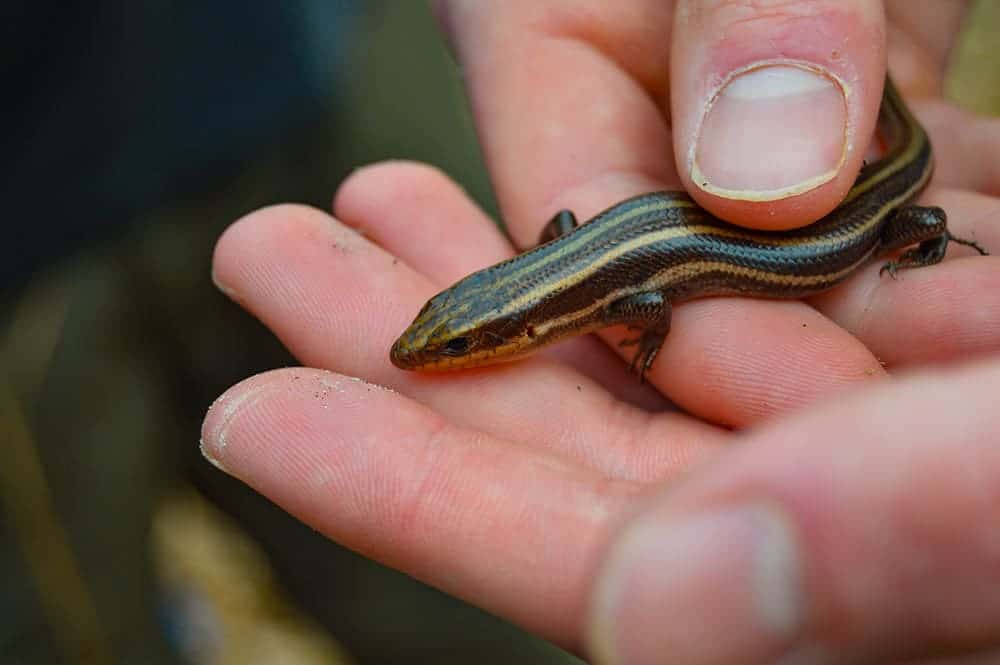
| Species: | Plestiodon anthracinus |
| Longevity: | 6 years |
| Good to own as a pet?: | Yes |
| Legal to own?: | Yes |
| Adult size: | 5 to 7 inches |
| Diet: | Carnivore |
The Coal skink has four light-colored stripes on the back, extending to the tail but not the head. During the breeding season, males have an orange to reddish coloring on the sides of their heads. The species is often found in humid regions, near springs, or wooded hillsides. Other coal skinks have been found in rocky areas.
Their mating season starts in late spring/early summer. The females lay 4 to 9 eggs in damp soil and defend them until they hatch.
Coal skinks feed on arthropods, which include earthworms, termites, larvae, and pupae. Their predators include raccoons, crows, hawks, herons, larger lizards, and snakes.
Young skinks with blue tails are sometimes thought to have a poisonous sting like a scorpion. Luckily, this is a false myth.
6. Five-Lined Skink
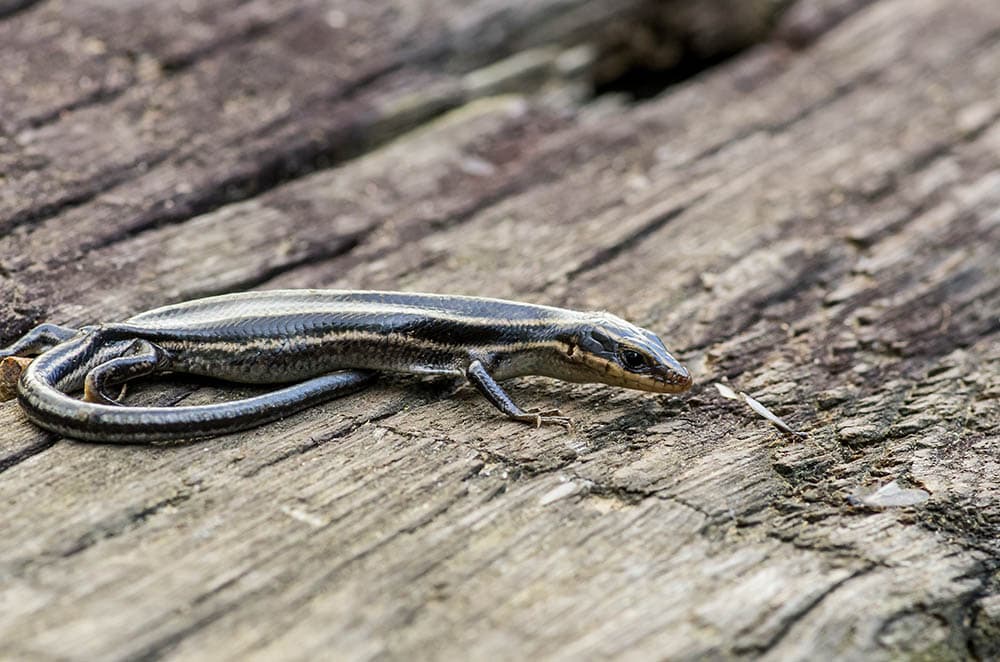
| Species: | Plestiodon fasciatus |
| Longevity: | 6 years |
| Good to own as a pet?: | Yes |
| Legal to own?: | Yes |
| Adult size: | 5 to 8.5 inches |
| Diet: | Carnivore |
As the name suggests, these skinks have five equal-width, yellow, or cream stripes on their body. Juvenile five-lined skinks have blue tails that fade into gray, green, or brown with age. Males develop a reddish-orange coloration on the snout and jaws during the mating season.
These North Carolina lizards prefer partially or moist wooded areas with significant basking sites. You can find them in stumps, logs, brush piles, and abandoned buildings. Adult males are territorial, and they defend it aggressively against other males. However, they do not mind females.
Like the Coal skink, the Five-lined skink feeds primarily on insects, tiny frogs, and snails. The creatures are susceptible prey to birds of prey, cats, and snakes. To evade capture, the lizard distracts the predator by detaching its tail. Luckily, the nail regrows.
7. Southeastern Five-Lined Skink
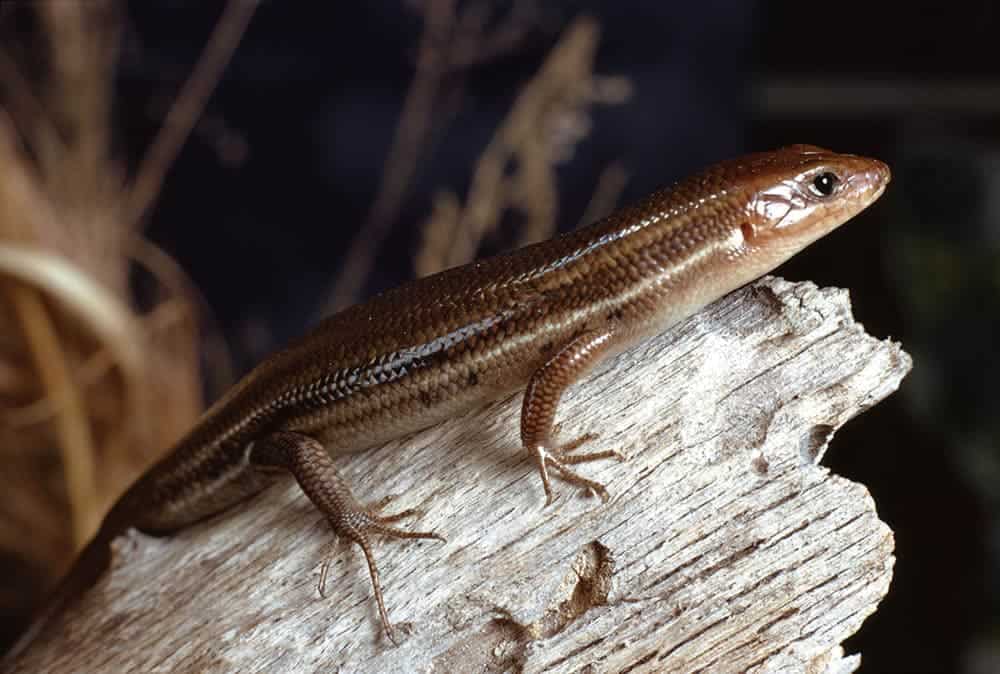
| Species: | Plestiodon inexpectatus |
| Longevity: | 6 to 10 years |
| Good to own as a pet?: | Yes |
| Legal to own?: | Yes |
| Adult size: | 5.5 to 8.5 inches |
| Diet: | Carnivore |
This species has five light stripes on its back like the five-lined skink. The Southeastern five-lined skink has a narrow middle strip that differentiates it from the rest. It also has the same-size scales on the bottom side of the tail.
Adult male heads have an orange-brown coloration during the breeding season. Juveniles have bright blue tails that fade with time.
The lizard has climbing skills but spends most of its days on the ground. Its typical habitats are dry, sandy environments or arid, wooded regions. The skink’s diet includes spiders, insects, and other invertebrates.
8. Six-Lined Racerunner
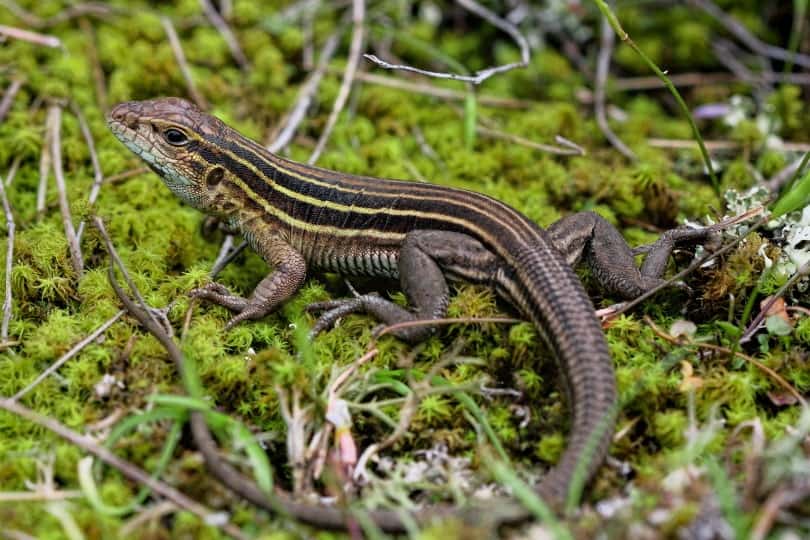
| Species: | Aspidoscelis sexlineatus |
| Longevity: | 6 years |
| Good to own as a pet?: | Yes |
| Legal to own?: | Yes |
| Adult size: | 6 to 9.5 inches |
| Diet: | Carnivore |
You can derive two things about this lizard from its name. First, it has six stripes running down its back. Second, it has impressive lightning speed. When threatened, it can run up to twenty-nine kilometers an hour.
The lizards have slim bodies and long tails. They are black, brown, or olive and have velvety skin. Adult males have bright blue or green coloration on the throat during the mating season.
The species lives in dry, open areas with little vegetation or loose soil. They burrow in the ground to look for insects and hide under rocks, creeks, and pools to hide from predators.
Their breeding season starts in late April until July, where females lay up to 6 eggs. Unlike the five-lined skink, the six-lined skink does not protect its eggs.
9. Broad Headed Skink

| Species: | Plestiodon laticeps |
| Longevity: | 4 to 8 years |
| Good to own as a pet?: | Yes |
| Legal to own?: | Yes |
| Adult size: | 6 to 13 inches |
| Diet: | Carnivore |
It is safe to say that the broadhead skink is one of the big lizards in North Carolina. Their large size and five labial scales distinguish them from other skinks.
Adult broad-headed skinks are olive-brown, gray, brown, or black. Hatchlings have five white or yellowish stripes and bright blue tails that fade. The females, however, retain their lines. Adult males develop orange color heads and wide, powerful jaws.
These arboreal lizards are commonly found in swamp forests or abandoned buildings. They lay their eggs under logs or sawdust piles.
This lizard species controls insect populations in the ecosystem. Their diet includes grasshoppers, beetles, cockroaches, and at times earthworms. But like their prey, they too have cats, birds, and larger reptiles as predators. They avoid being eaten by detaching their tail.
10. Little Brown Skink

| Species: | Scincella lateralis |
| Longevity: | 2 to 3 years |
| Good to own as a pet?: | Yes |
| Legal to own?: | Yes |
| Adult size: | 3 to 5.75 inches |
| Diet: | Carnivore |
If you are looking for small lizards in North Carolina, well, you’ve got one. The ground skink is tiny, with a dark stripe running along its side. Its coloration ranges from golden brown, coppery brown, or black, depending on its habitat. The belly can be yellow or white.
Ground skinks never climb. Instead, they prefer living in areas with abundant leaf critters and loose soil. When spotted by predators, they utilize their slim bodies to disappear. They wriggle through soil and leaf litter in a flash. In addition, they can break off their tail when escaping.
These lizards prey on insects, spiders, and isopods.
11. Slender Glass Lizard
| Species: | Ophisaurus attenuates |
| Longevity: | 10–30 years |
| Good to own as a pet?: | Yes |
| Legal to own?: | Yes |
| Adult size: | 22 to 42 inches |
| Diet: | Carnivore |
The slender glass lizard has no legs and can be mistaken for a snake. However, it does not slither on its stomach like a snake. Instead, it slides and pushes its body in a sideways motion. In addition, it can close its eyes and has external ear openings for sound.
It acquired its ‘glass lizard’ name from its behavior. When caught, it breaks off its tail to escape. The tail shatters into many pieces like glass. Moreover, their bodies are fragile and easily broken when mishandled.
The slender glass lizard eats almost everything that can fit into its mouth. This includes insects, beetles, crickets, grasshoppers, and small lizards.
12. Eastern Glass Lizard
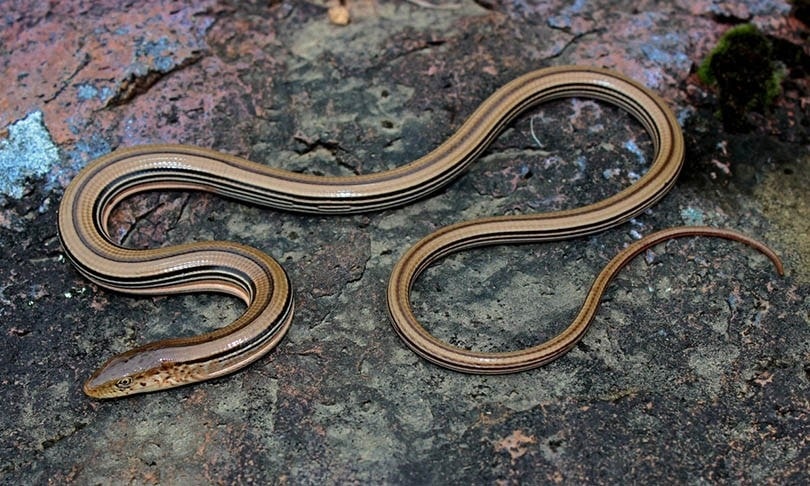
| Species: | Ophisaurus ventralis |
| Longevity: | 10 years |
| Good to own as a pet?: | Yes |
| Legal to own?: | Yes |
| Adult size: | 18 to 42.6 inches |
| Diet: | Carnivore |
The Eastern glass lizard also resembles snakes, but they have external ear openings, moveable eyelids, and inflexible jaws. These long, slender, and legless lizards are light brown, yellowish, or greenish. Unlike other glass lizards, they lack a dark dorsal stripe on their back.
They are active during the day and can be found either hunting or basking. Their diet includes insects, arthropods, and small invertebrates. They, in turn, are food for raccoons, hawks, and snakes.
13. Mimic Glass Lizard
| Species: | Ophisaurus mimicus |
| Longevity: | 10 years |
| Good to own as a pet?: | Yes |
| Legal to own?: | Yes |
| Adult size: | 15 to 26 inches |
| Diet: | Carnivore |
North Carolina is also home to this small, tan, or brownish lizard. It has a black or dark brown mid-dorsal stripe. In addition, there are three to four rows of spotted dark stripes above its lateral groove.
The lizard is diurnal, but males are generally more active. They are often found in open woodlands, pine forests, and southern coastal plains.
They eat insects, spiders, snails, small rodents, small snakes, and lizards.

Conclusion
The above 13 types of lizards are found in North Carolina. If you were worried there could be poison lizards in your home, fear not. These species are shy and harmless. Besides, they also make great pets for beginners and kids. However, the Texas horned lizard does not survive long in captivity.
Featured Image Credit: Peter Paplanus, PxHere
